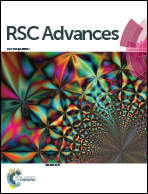Determination of cesium ions in environmental water samples with a magnetic multi-walled carbon nanotube imprinted potentiometric sensor†
Abstract
A potentiometric sensor, based on the glassy carbon electrode (GCE) modified with a magnetic multi-walled carbon nanotubes/cesium ion-imprinted polymer composite (MMWCNTs@Cs-IIP), is introduced for the detection of cesium(I). The IIP was synthesized using cesium ions as the template ions, chitosan as the functional monomer and glutaraldehyde as the cross-linking agent. The membrane, which was coated on the surface of the GCE, was prepared using MMWCNTs@Cs(I)-IIP as the modifier, PVC as the neutral carrier, 2-nitrophenyloctyl ether as the plasticizer and sodium tetraphenylborate as the lipophilic salt. The proposed sensor exhibited a Nernstian slope of 0.05954 V dec−1 in a working concentration range of 1 × 10−7 to 1 × 10−4 M (mol L−1) with a detection limit of 4 × 10−8 M. The sensor exhibited high selectivity for cesium ions and was successfully applied for the determination of Cs(I) in real samples.



 Please wait while we load your content...
Please wait while we load your content...